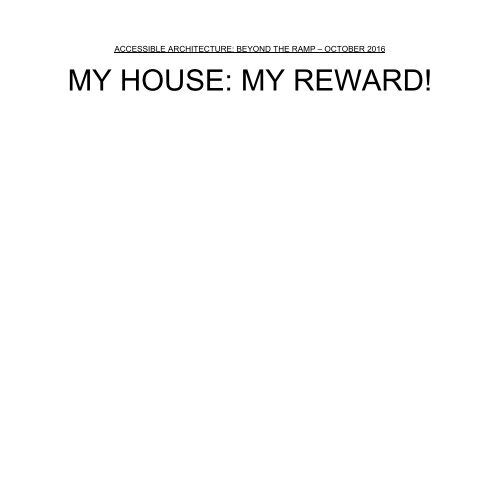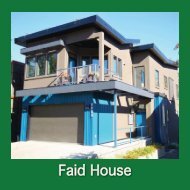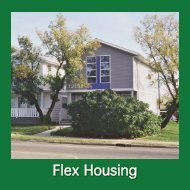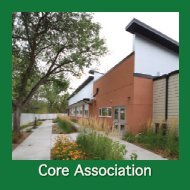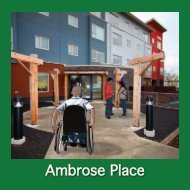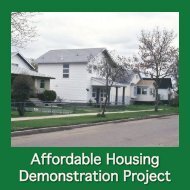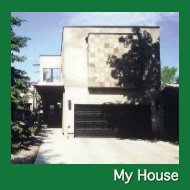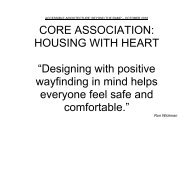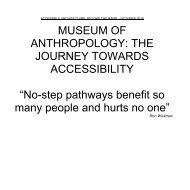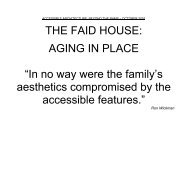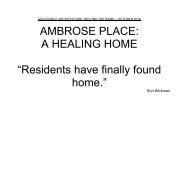My House
Project by Ron Wickman Architect
Project by Ron Wickman Architect
You also want an ePaper? Increase the reach of your titles
YUMPU automatically turns print PDFs into web optimized ePapers that Google loves.
ACCESSIBLE ARCHITECTURE: BEYOND THE RAMP – OCTOBER 2016<br />
MY HOUSE: MY REWARD!<br />
205
ACCESSIBLE ARCHITECTURE: BEYOND THE RAMP – OCTOBER 2016<br />
The above image is a scale model of our new family home viewed from the south.<br />
Like most architects, the design and re-design of our family home was de rigueur. In 2000, we<br />
completed a second-story addition to our 1960s bungalow. The home modifications were designed<br />
primarily to accommodate the growing needs of our family of five. Accessibility and sustainability<br />
were also important architectural concerns. The sustainable features include passive solar design;<br />
a well insulated building envelope, low-flow toilets, and a green roof.<br />
To make the home more accessible, all public spaces are clustered on the ground floor; we poured<br />
a sloping sidewalk at the front entrance.<br />
206
ACCESSIBLE ARCHITECTURE: BEYOND THE RAMP – OCTOBER 2016<br />
The above image shows the front view of our new two-story home, facing east.<br />
The home is located in a quiet late sixties south-side suburb along a beautiful street lined with elm<br />
trees. The existing 1400 SF bungalow doubled in size, with the renovated home providing more<br />
room for the family and for my home office. The addition to the home goes up rather than out.<br />
Located at the intersection of two back lanes, the home is sited on an east-west axis. Its south side<br />
faces one of the two lanes with better access to the sun. The home location is ideal with the added<br />
advantage of being located in a mature neighborhood close to a variety of amenities and public<br />
transportation.<br />
207
ACCESSIBLE ARCHITECTURE: BEYOND THE RAMP – OCTOBER 2016<br />
The above floor plan drawing illustrates the main floor of the home, wherein all the public spaces<br />
of the house are clustered, including my home office.<br />
The office has a separate entrance at the front of the house, which can easily be blocked off from,<br />
or opened up to the rest of the living space, depending on the family’s needs. In the future, the<br />
space could be used as an in-law suite, or for an adult child still living at home. The crisp lines of<br />
this design are clearly inspired by the work of the early modernists with the house acting as a<br />
backdrop to human activities. A variety of box forms, devoid of any unnecessary embellishments,<br />
articulate the various functions of the building. Like later modernists, such as Alvar Aalto, the house<br />
utilizes a more human scale and warmer local building materials. Indeed, this house renovation<br />
looks to the past for inspiration, although it is more focused on today’s social and political conditions,<br />
and on our need to respect our fragile environment.<br />
208
ACCESSIBLE ARCHITECTURE: BEYOND THE RAMP – OCTOBER 2016<br />
The above floor plan illustrates the second floor of the home.<br />
The design is straightforward with the house functions clearly divided into their constituent parts<br />
and the building’s form derived from the order of the interior and exterior spaces. A northern, twostory<br />
block contains the private spaces with four bedrooms on the second floor, and a home office,<br />
a sitting room, and a garage on the main floor. A south facing one-story block contains the public<br />
spaces on the main floor, topped off by a roof deck. A distinct third block, built at a height between<br />
the two other blocks, weaves the private and public realms together. This in-between space<br />
contains two levels of circulation complete with sitting areas, and serves to provide a positive<br />
connection between the public and private functions. Architects should spend more design time on<br />
these in-between spaces, since they are critical in imbuing meaning to the various functions in a<br />
single-family dwelling and in an entire city. Carefully constructed outdoor spaces also link the home<br />
to the rest of the community. The design of these outdoor rooms—the roof deck, front courtyard,<br />
and back play area—are every bit as important as the indoor spaces providing variety and<br />
personalization to this design.<br />
209
ACCESSIBLE ARCHITECTURE: BEYOND THE RAMP – OCTOBER 2016<br />
The above image of the stairs leading to the second floor utilizes color and textural contrast to help<br />
persons with low vision in their wayfinding.<br />
The stairs are finished in dark slate tile with light colored maple nosings. The high contrast makes<br />
it very easy for users to identify each individual stair. <strong>My</strong> design decisions—to be as accessible as<br />
possible— are based on maximizing the experiences of end users. There are no steps at the front<br />
door, allowing persons in wheelchairs to access the main floor independently. A residential elevator<br />
would be required to make the second floor wheelchair accessible. The home also bridges<br />
affordability and ecological design and construction, while highlighting green-building materials and<br />
methods that are easy to obtain and simple to use.<br />
210
ACCESSIBLE ARCHITECTURE: BEYOND THE RAMP – OCTOBER 2016<br />
The above image is a rendering by Jared Schmidts of my father moving up the sloping sidewalk to<br />
the front door of my house, from my adult children’s book Accessible Architecture: A Visit from<br />
Pops.<br />
“Buildings should never be designed simply as sculpted objects to be viewed; the design aims to<br />
be usable by as many people as possible.<br />
When architects design buildings that cannot accommodate people with disabilities and others, the<br />
strength of their design is compromised. Accessible architecture is not about limiting design options.<br />
It is about bringing value and meaning to design.”<br />
211


